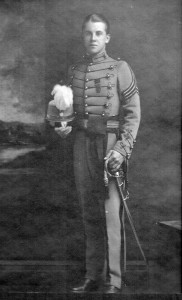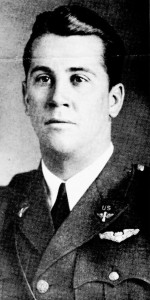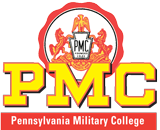 For 150 years, PMC taught students to be academically disciplined and instilled in them the qualities of leadership. Two brothers, Hugh and Joe McCaffery (read more), learned these lessons well and were superior leaders at a time when the nation needed them.
For 150 years, PMC taught students to be academically disciplined and instilled in them the qualities of leadership. Two brothers, Hugh and Joe McCaffery (read more), learned these lessons well and were superior leaders at a time when the nation needed them.
Hugh McCaffrey ‘24 started in the PMC Prep School and then entered the college. During his time at PMC he was a multi-sport athlete, football, basketball and baseball, and was admired by his classmates for his energy and leadership. As the quarterback of the football team, McCaffrey was considered by many, including Col. Frank Hyatt, to be “slightly” better than Reds Pollock ’34. In 1924, he received his Degree in Civil Engineering from PMC and was commissioned as a Second Lieutenant in the Army Reserves. McCaffery then entered law school at Notre Dame University. While there, he joined the swim team, became the team’s captain, set collegiate records in the 100-meter freestyle, and qualified for the Olympics swim team. After earning his law degree, his interest in flying took him in a different direction.
McCaffery was a gifted pilot. Before joining the Army Air Corps in 1930, he graduated from the School of Aviation at Essington, PA. He then joined the Army Air Corps and completed flying school at Randolph Field in Texas. Thereafter, he received specialized training in pursuit, observation and bombardment in a variety of airplanes. Upon completing his training, he was assigned to the 31st Bombardment Squadron. In 1939, he was an instructor at the Air Navigation School at Hickam Field in Hawaii. In 1940, he was put in charge of the squadron.
 Shortly after the attack on Pearl Harbor, Secretary of War Stimson ordered Major General Herbert A. Dargue, an aviation pioneer and commanding officer of the First Air Force, and his staff, including Major McCaffery, to investigate the lack of preparedness at Pearl Harbor and to take command of the Army units in Hawaii. On December 12, 1941, while flying a Douglas B-18 enroute to Hamilton Field in California, McCaffrey encountered a snow storm as he approached the Sierra Nevada Mountains and subsequently went missing. An exhaustive search was conducted. It wasn’t until May, 1942, that a search party led by Norman Clyde, a well-known mountaineer with experience in the Sierra Nevada, found the aircraft and bodies, covered by five feet of snow.
Shortly after the attack on Pearl Harbor, Secretary of War Stimson ordered Major General Herbert A. Dargue, an aviation pioneer and commanding officer of the First Air Force, and his staff, including Major McCaffery, to investigate the lack of preparedness at Pearl Harbor and to take command of the Army units in Hawaii. On December 12, 1941, while flying a Douglas B-18 enroute to Hamilton Field in California, McCaffrey encountered a snow storm as he approached the Sierra Nevada Mountains and subsequently went missing. An exhaustive search was conducted. It wasn’t until May, 1942, that a search party led by Norman Clyde, a well-known mountaineer with experience in the Sierra Nevada, found the aircraft and bodies, covered by five feet of snow.
On the evening of October 14, 1949, the Corps of Cadets gathered in the Armory to hear Bill Stern, ’30 (read more) noted sports broadcaster. During his 15-minute, coast-to-coast broadcast that evening, Stern paid tribute to Hugh and Joe McCaffery, who had been killed in action. Any death in war is tragic. For PMC, the loss of the McCaffery boys was very personal and underscored the sacrifice PMC has made while serving our country.

